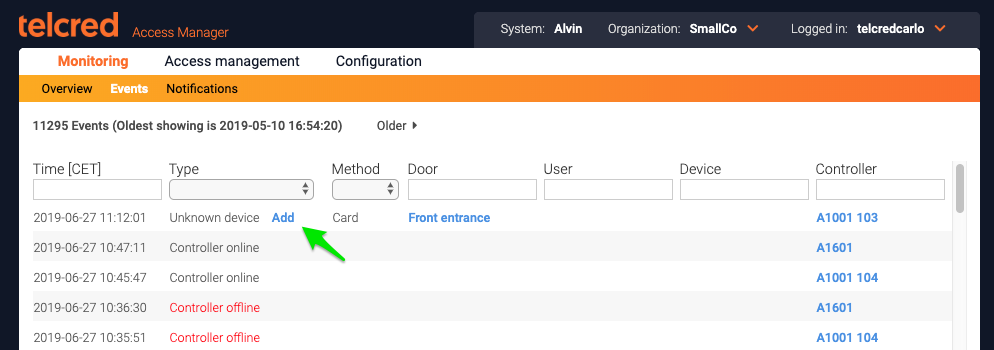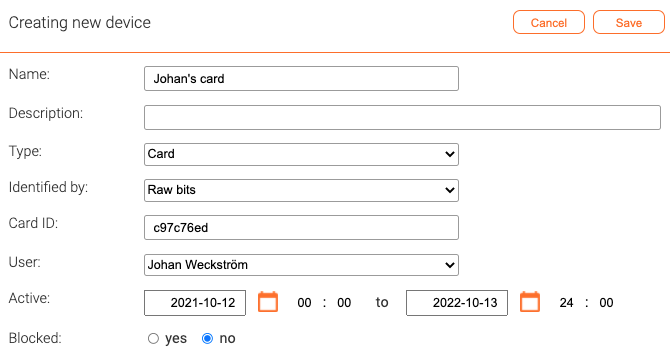Cards: Difference between revisions
No edit summary |
No edit summary |
||
| Line 28: | Line 28: | ||
A card can only belong to one user at the time, but it is possible to reassign it from one user to another. |
A card can only belong to one user at the time, but it is possible to reassign it from one user to another. |
||
The fields for a card are: |
|||
* ''Name''. The only mandatory field |
|||
* ''Notes''. Optional and for information only |
|||
* ''Identified by''. Can be 'Raw bits' or 'Number'. We recommend to always use Raw bits, which is exactly what the card reader sends to the controller. If the reader model does some pre-processing of the card identity, it can sometimes work to use 'Number' instead |
|||
* ''Card ID''. The ID of the card as sent by the card reader |
|||
* ''User''. The owner of the card |
|||
* ''Active''. It is possible to set a date range for when the card should be active |
|||
* ''Blocked''. A card which has been lost can be blocked. In this case it will noty be able to open doors. If the card is found again it can be unblocked |
|||
At the bottom of the page, there is a link that lets you [[Validating access|check the access rights for the card]]. |
|||
Revision as of 19:54, 14 December 2022
Cards refers to both actual cards and keyfobs.
Adding a card
A common way to add a new card to the system is to first touch it to a connected reader. Then select Events in the Monitoring section of the menu. An unknown device should appear at the top of the list with a link to add it (it can take a few seconds before the event shows up).
Click the link to add the information for the new card:
When adding a new card it is required to give it a name. It is also possible to enter an optional description.
The field Identified by has two possible values: Raw bits and Number. Raw bits is the default and means that the card is identified by all the bits that the reader receives from the card. If raw bits is chosen, the Card ID needs to be entered with hexadecimal notation (this is done automatically if the card registration process above is followed).
If, instead, the card should be identified by Number, the Card ID should be entered as a decimal number (e.g. 12408).
In general, it is always better to use Raw bits and the only reason to use Number is for backwards compatibility with a previous access control system (for example, if the customer already has a large number of cards for which only the decimal number is known, and it is not practical to collect and re-register the cards).
The card can be assigned to a user in this screen or it can be done in the User screen. It is possible to specify the time period during which the card should be active. A card which does not belong to a user or is no longer active is not able to open any doors.
A card can be temporarily blocked, e.g. if it is lost. If found again, the card can simply be unblocked.
A card can only belong to one user at the time, but it is possible to reassign it from one user to another.
The fields for a card are:
- Name. The only mandatory field
- Notes. Optional and for information only
- Identified by. Can be 'Raw bits' or 'Number'. We recommend to always use Raw bits, which is exactly what the card reader sends to the controller. If the reader model does some pre-processing of the card identity, it can sometimes work to use 'Number' instead
- Card ID. The ID of the card as sent by the card reader
- User. The owner of the card
- Active. It is possible to set a date range for when the card should be active
- Blocked. A card which has been lost can be blocked. In this case it will noty be able to open doors. If the card is found again it can be unblocked
At the bottom of the page, there is a link that lets you check the access rights for the card.
At the bottom of the page, there is a link that lets you check the access rights for the user.

